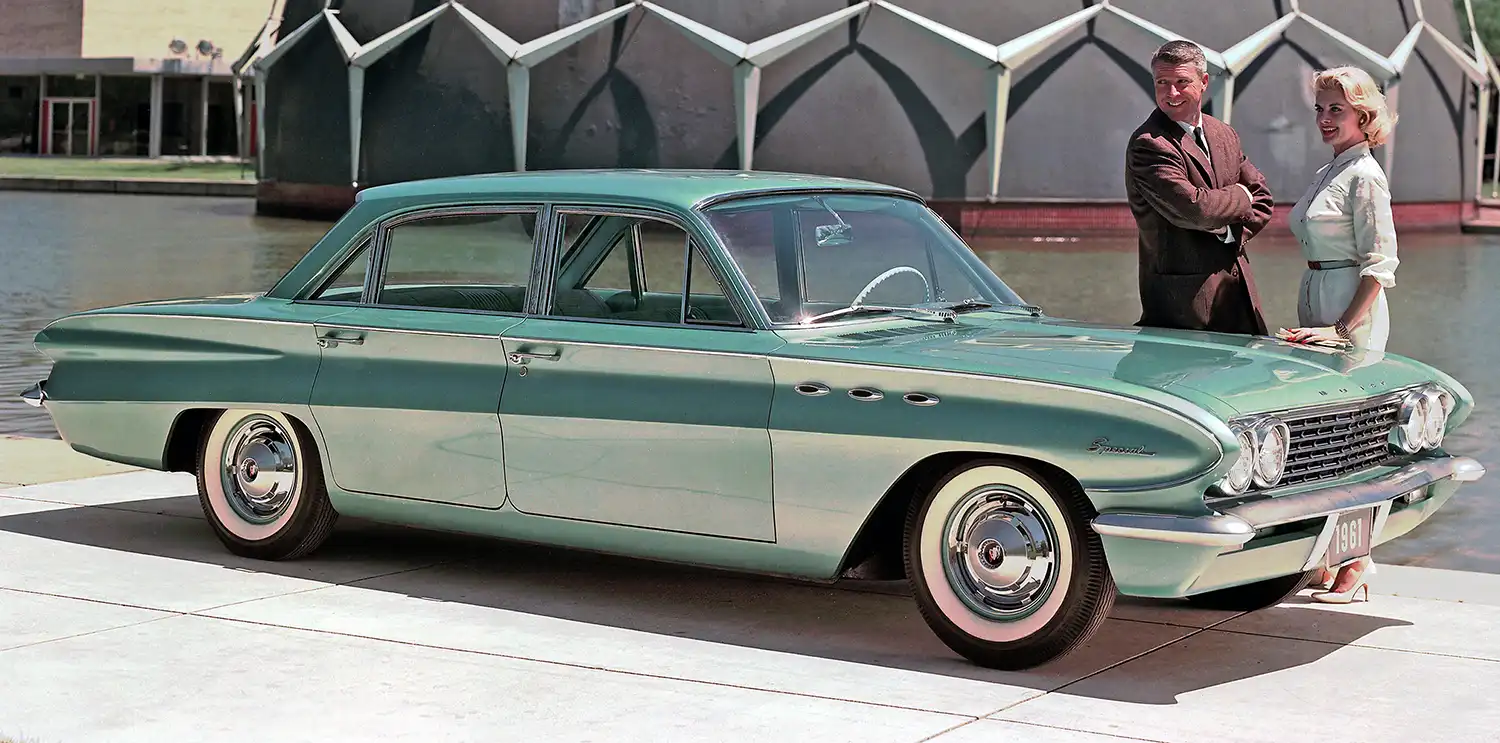
The Buick Special, a nameplate with a long and storied history, underwent a significant transformation for the 1961 model year. Originally introduced in 1934 as Buick’s entry-level model, the Special had evolved through various iterations. The 1961 redesign marked a shift to a more compact platform, a move driven by changing market demands and a growing interest in smaller, more fuel-efficient vehicles. This downsized Special, including the uplevel Special Deluxe trim, offered a fresh and modern design, a range of new engine options, and Buick’s traditional emphasis on comfort and value. The 1961 Buick Special Deluxe aimed to appeal to a broader audience, offering a stylish and well-equipped alternative in the burgeoning compact car segment while still retaining some of the upscale touches associated with the Buick brand.
Modern and Distinctive Styling: The 1961 Buick Special Deluxe showcased a clean and contemporary design that was a departure from the larger, more fin-heavy cars of the late 1950s. Its crisp lines, minimal ornamentation, and a more compact footprint gave it a fresh and modern appeal. The front end typically featured a horizontal bar grille with the Buick tri-shield emblem, flanked by dual headlights. The body sides were relatively smooth, often accented by a subtle character line or trim. The rear end design was clean and uncluttered, often featuring horizontal taillights. Available in various body styles, including a two-door coupe, a four-door sedan, and a versatile station wagon, the Special Deluxe offered practicality and style to suit different needs. The overall design reflected a move towards more efficient packaging and a more European-influenced aesthetic, aligning with the trends of the early 1960s.
Comfortable and Well-Appointed Interior: Despite its more compact dimensions, the interior of the 1961 Buick Special Deluxe was designed to offer a comfortable and well-appointed environment for its occupants. Bench seats, typically upholstered in durable fabrics or vinyl, provided seating for up to six passengers. The dashboard featured a clean and functional layout, with easy-to-read gauges and controls. The Special Deluxe trim often included upgraded interior materials and trim accents compared to the base Special, enhancing the sense of value and comfort. Available features could include a heater and defroster, an AM radio, and various other options to improve the driving experience. The emphasis was on providing a practical and comfortable cabin that was well-suited for everyday use, while still offering a step up in terms of features and refinement compared to more basic compact cars.
Innovative New Engine Options: A significant aspect of the 1961 Buick Special Deluxe was the introduction of new and more efficient engine options. Compact Power and Efficiency: The standard engine was an all-new 198 cubic inch “Fireball” V6 engine. This marked a notable shift for Buick, as V6 engines were less common in American cars of this era. The V6 produced around 135 horsepower and offered a good balance of performance and fuel economy for the smaller platform. An optional 215 cubic inch aluminum block V8 engine was also available, producing around 155 horsepower and offering more spirited performance. These engine choices, paired with either a standard three-speed manual or an optional two-speed Turbine Drive automatic transmission, provided a range of performance characteristics to suit different driving needs and preferences. The focus on more compact and efficient engines reflected the changing automotive landscape and Buick’s adaptation to these trends.
Balanced Ride and Handling: The 1961 Buick Special Deluxe was engineered to provide a comfortable and balanced driving experience. Its unit-body construction, a departure from the traditional body-on-frame design, contributed to a lighter weight and improved structural rigidity. The suspension system was designed to offer a smooth ride while still providing adequate handling for everyday driving. Power steering was available as an option, making maneuvering easier, especially in urban environments. The overall driving experience was characterized by a sense of nimble handling and comfortable cruising, making it a pleasant car to drive for both short trips and longer journeys. The smaller size and lighter weight compared to Buick’s larger models contributed to a more responsive feel behind the wheel.
A Step Towards the Future: The 1961 Buick Special Deluxe represented a significant turning point for the Buick brand, demonstrating its willingness to adapt to the changing automotive market by offering a stylish, more compact, and fuel-efficient vehicle. Its modern design, comfortable interior, and innovative engine options, particularly the new V6, made it a compelling choice in the growing compact car segment. While still retaining Buick’s emphasis on value and a degree of refinement, the 1961 Special Deluxe appealed to a broader range of buyers. It laid the groundwork for future generations of Buick’s smaller models and remains a notable example of the shift towards more efficient and thoughtfully packaged automobiles in the early 1960s. Its legacy lies in its successful adaptation to market trends while still maintaining some of the core values associated with the Buick name.
Summary:
- Redesigned as a more compact model for 1961.
- Offered a fresh and modern design.
- Introduced a new “Fireball” V6 engine.
- Optional aluminum block V8 engine also available.
- Unit-body construction for lighter weight and improved rigidity.
- Comfortable and well-appointed interior.
- Represented Buick’s entry into the more compact segment.
- A significant model in Buick’s history, adapting to changing market demands.
Disclaimer: Information provided is based on general automotive knowledge and historical data regarding the 1961 Buick Special Deluxe. Specific engine options, horsepower ratings, and available features may have varied. Consult original specifications and documentation for precise details.
Source: Buick
AI Assistance: Gemini
